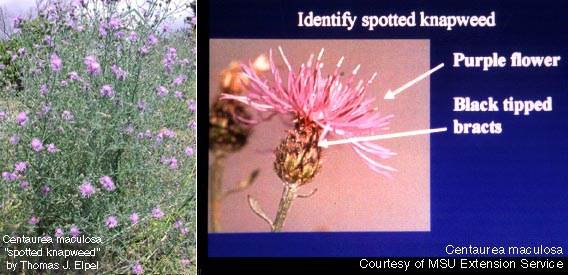
 2
2




This is what I found out about knapweed from this site: http://4e.plantphys.net/article.php?ch=&id=377: ; Using this approach, the phytotoxin present in spotted knapweed root exudates was identified as a racemic mixture of (±)-catechin (hereafter catechin) (Figure 2). Bioassays with the two enantiomers revealed that they have different effects. (−)-Catechin is a potent phytotoxin, whereas (+)-catechin is a weaker phytotoxin with some antimicrobial activity (Bais et al. 2002, 2003; Veluri et al. 2004). Purified catechin from spotted knapweed root exudates and commercially available catechin acted similarly against a wide variety of plant species in bioassays, suggesting the chemical identification was correct. While catechin was identified as the principle phytotoxin in spotted knapweed root exudates, other chemicals in spotted knapweed root exudates or plant tissue may have similar phytotoxic properties. Further, spotted knapweed may produce other phytotoxic compounds when grown under more realistic field conditions, as opposed to the highly artificial laboratory conditions used in these experiments. In the model plant Arabidopsis thaliana, distinct root exudation profiles are associated with different stages of development (Walker et al. 2003); thus it is possible that spotted knapweed may secrete different phytotoxic compounds at different stages of development.
However, at this site: http://www.ncbi.nlm.nih.gov/pmc/articles/PMC2676754/: Our paper strongly supports the view of others that (-)-catechin is not an allelochemical. This very weakly phytotoxic compound is found in exceedingly low concentrations, if at all, in the soil in which producing plants are found. Furthermore, it is very unstable in soil and in water, and its derivatives do not appear to be significantly phytotoxic. We hope that the findings that challenge the view that (-)-catechin is an allelochemical do not discourage others from initiating or continuing research in this intriguing area of chemical ecology.
Knapweed bio-controls… Yes a new topic would be in order.













"If you think organic food is expensive, have you priced cancer lately?"
JOEL SALATIN








"If you think organic food is expensive, have you priced cancer lately?"
JOEL SALATIN
 1
1










"If you think organic food is expensive, have you priced cancer lately?"
JOEL SALATIN













"If you think organic food is expensive, have you priced cancer lately?"
JOEL SALATIN








"If you think organic food is expensive, have you priced cancer lately?"
JOEL SALATIN








Brenda
Bloom where you are planted.
http://restfultrailsfoodforestgarden.blogspot.com/




 1
1












 2
2












www.thehappypermaculturalist.wordpress.com




Brenda
Bloom where you are planted.
http://restfultrailsfoodforestgarden.blogspot.com/




www.thehappypermaculturalist.wordpress.com




"Study books and observe nature. When the two don't agree, throw out the books" -William A Albrecht
"You cannot reason a man out of a position he has not reasoned himself into." - Benjamin Franklin
 2
2




 2
2




Learn permaculture beekeeping from your home! You can find it here at :
organiclifeguru.com/course/beekeeping-101-organic-natural-traditional/




 1
1




Learn permaculture beekeeping from your home! You can find it here at :
organiclifeguru.com/course/beekeeping-101-organic-natural-traditional/













Steve Flanagan wrote:...using sound permaculture design should reduce or eliminate knapweed where it is not desired. Does what I'm saying make sense?












Learn permaculture beekeeping from your home! You can find it here at :
organiclifeguru.com/course/beekeeping-101-organic-natural-traditional/













Learn permaculture beekeeping from your home! You can find it here at :
organiclifeguru.com/course/beekeeping-101-organic-natural-traditional/
 1
1





My tree nursery: https://mountaintimefarm.com/

|
I just had the craziest dream. This tiny ad was in it.
Learn Permaculture through a little hard work
https://wheaton-labs.com/bootcamp
|







